Blog: MAC-295-2797-It Ain’t Simply a Song and Dance: Reflections of Hollywood Musicals
Don't wanna be here? Send us removal request.
Text
The comment above is mine. The "I agree with this!" one.
Dharamputra
"Dharamputra", directed by Yash Chopra, intertwines themes of identity, religious division, and the social unrest that defined pre- and post-independence India (1925-1947). Set against this backdrop, the film delves into the story of Husn Bano, a young, unwed Muslim mother forced to give up her son due to societal pressures.
The film explores the human cost of such pressures, particularly on the identity of Indian Muslims. It exposes the phenomenon of "othering," where a dominant group constructs the "other" as different and potentially threatening. This concept becomes tragically relevant in the wake of Partition, as Dilip, raised as a Hindu and indoctrinated with nationalist fervor, struggles to reconcile his upbringing with the sudden revelation of his Muslim heritage.
Dilip's transformation from innocence to bigotry reflects the escalating religious tensions of the era. He embodies the "othering" process, becoming a staunch Hindu fundamentalist who actively opposes non-Hindu beliefs. As Sony Jalarajan Raj and Adith K. Suresh discuss in Reframing Islam in bollywood cinema: a study on the construction of the Islamic identity in Indian cinema, "Partition of the Indian subcontinent unilaterally separated individuals into elusive categorizations of ‘us’ and ‘them’". The film portrays the loss of a shared Hindu-Muslim identity post-Partition, highlighting the devastating impact of societal pressures and nationalistic ideology on individuals and communities.
In conclusion, while "Dharamputra" doesn't explicitly offer a path towards healing the divides, it is a reminder of the human cost of religious polarization and the enduring need for understanding and tolerance in a divided world. By showcasing the tragic consequences of othering and the loss of identity, the film compels viewers to critically examine their own biases.

Works cited:
Jalarajan Raj, Sony, and Adith K. Suresh. "Reframing Islam in bollywood cinema: a study on the construction of the Islamic identity in Indian cinema." Asian Journal of Communication (2023): 1-15.Harvard
8 notes
·
View notes
Text
Viewing Response 4: Rolling Up the Partition II: Dharamputra (1961)

Yash Chopra's Dharamputra (1961) is a tale of two families--a muslim, and a hindu family-during the mid 20th century in India when it is under British rule. The film examines the political and religious turmoil of the time through the unfolding of the two families' joint secret.
A pregnant Husn Bano, the unmarried daughter of Nawab Badruddin, is forced to give up her child, Dilip, to be raised by the son of her father's friend, Amrit Rai and his wife, Savitri. Bano is able to watch as Dilip grows as the two families' houses are combined, however she moves away when she remarries. Upon her return, she learns her son Dilip has become an ardent anti-muslim activist, set on ridding India of Muslims.

The scene I chose is a musical scene where a Hindu singer and a Muslim singer are singing a song titled, "Ye masjid hai, wo butkhana/This is a mosque, and that's a temple". This is scene is important as it captures the essence of the film. Though the two families are of different religions, they symbolize a certain harmony between two faiths seeing as they live in the same home. The song preaches that despite the difference of religion, they are all Indian. The meaning of the song is intensified by its expression through song as it is a literal representation of the harmony that can be achieved.
In their article, Reframing Islam in bollywood cinema: a study on the construction of the Islamic identity in Indian cinema, Sony Jalarajan Raj & Adith K. Suresh write, "Partition films attempt to picture the process of sectarianizing the Indian subcontinent into the categories of ‘Indian Muslims’ and ‘Indian Hindus’ where the former is delegi- timized and denigrated to the point of completely detaching the ‘Indianness’ from their identity" (Raj & Suresh, 358-9). I believe this speaks greatly to the importance of the musical scene attached below, as it brings light to the reality at hand. The reality being that it is not any certain faith that makes a nation, but the people themselves, no matter their religion.
youtube
1 note
·
View note
Text
I think it is interesting to note that as this film embodies all that old Hollywood and even Hollywood now perceives a musical to be, it also happens to use songs that carry much historical and racial weight, and diminish it. With Hollywood's extravagant sets and performances, it is easy to lose sight of the song's actual purposes and intended audiences/singers.
Roundtable 3: Till The Clouds Roll By (1946)
Richard Whorf's Till the Clouds Roll By is a 1946 biopic of American Broadway pioneer Jerome Kern. It features renditions of Kern's famous songs from his musical plays performed by contemporary stage artists. The film follows Kern's journey from his early days as a struggling songwriter to his rise as one of the most influential figures in American musical theater.
Jerome Kern was an American composer whose breakthrough came with the musical Show Boat (1927). Throughout his career, Kern composed numerous hit songs that became standards of the American songbook. Kern's influence extended beyond Broadway, as he also composed music for Hollywood films. He received multiple Academy Award nominations for his film work, including for the score of "Swing Time" (1936), which featured the classic song "The Way You Look Tonight."

What are the social aspects within the film’s narrative that align with the film’s songs?
In Till the Clouds Roll By, every song serves as a snapshot from one of Jerome Kern's musicals. Each of his musicals has various themes that are reflected in these performances. For instance, the film delves into the pursuit of artistic success and recognition within the competitive world of musical theater, as seen in the song "Make Believe" from Showboat. Performances of songs like "Can't Help Lovin' Dat Man" and "The Folks Who Live on the Hill" create sentiments of longing, desire, and devotion, mirroring the characters' experiences of love and heartache against the backdrop of their personal and professional lives.
Through these performances, audiences are transported into the intimate moments of the characters' lives, witnessing the highs and lows of their relationships unfold on screen. The emotional depth and vulnerability conveyed through these songs resonate with audiences on a profound level, inviting them to reflect on their own experiences of love and longing.
2. How do the historiographies of previously recorded songs inform audience relationships with the musical's narrative and performers?
By incorporating these well-known songs into the film, Till the Clouds Roll By establishes a connection with audiences who may be familiar with the original recordings. The historiographies of these songs evoke a sense of nostalgia and recognition, inviting audiences to engage with Kern's work on a deeper level. As audiences listen to familiar tunes reinterpreted within the context of the film, they are reminded of past performances and experiences, enriching their understanding and appreciation of the narrative unfolding on screen. Each performance is set against the backdrop of theatrical stages that include similar set designs and costumes to those of Kern's musical plays.
A notable example of this homage is Caleb Peterson's rendition of "Ol' Man River" from Kern's seminal work, Show Boat. In the film, we see the character Joe, a Black dock worker grappling with the struggles faced by African Americans along the Mississippi River. Peterson's performance captures the essence of Kern's vision for the film. He is dressed in attire similar to Joe's character and surrounded by a stage design reminiscent of the riverfront setting.
youtube
Later on, the film's set design shifts completely and we see Frank Sinatra's rendition of "Ol' Man River" towards the end. Sinatra's performance is set against the backdrop of a grand orchestra and adorned in an all-white suit.
youtube
While Peterson's rendition authentically captures the struggles of marginalized communities and serves as a powerful commentary on racial inequality, Sinatra's interpretation almost overshadows this narrative depth. The contrast between Peterson's portrayal of a Black dock worker and Sinatra's performance with overwhelming privilege and sophistication, dilutes the real meaning behind the song, shifting the focus away from the authentic representation of racial struggle.
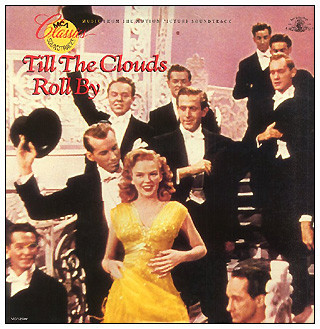
3. What musical genre/style drives the film’s score, and how does the genre/style (re)define the film as a musical?
Alberto Mira's "Introduction: The Hollywood Musical is Dead. Long Live the Hollywood Musical!" provides valuable insights into the evolution and significance of the Hollywood musical genre, which can be applied to understanding Till The Clouds Roll By. Mira's discussion of the Hollywood musical's cultural significance underscores the importance of the genre as a reflection of societal values and aspirations. Till the Clouds Roll By embodies this aspect by exploring themes of ambition, love, and social justice through its musical performances and narrative arcs. The film serves as a testament to the enduring appeal of the Hollywood musical genre and its ability to resonate with audiences across generations.
The film's score is predominantly driven by the musical genre/style of traditional Broadway and musical theater. This genre/style is characterized by orchestration, melodies, and elaborate vocal performances that serve to advance the narrative and evoke the emotions of the different characters. The genre/style of traditional Broadway and musical theater (re)defines the film as a musical by infusing it with elements such as elaborate song and dance numbers, theatrical staging, and larger-than-life performances. These elements serve to heighten the emotional impact of the narrative and create a sense of spectacle that is characteristic of the musical genre.
14 notes
·
View notes
Text
I think it was an interesting and effective choice for this film to be comedic. The issue of rock and roll being a poor influence on youths back when it was becoming popular is a conversation that can be looked back on with much humor, though it continues in a way today. I think the point of the comedy though was to comment on how rock and roll caused such a stir among fans and critics alike, and how that disagreement might seem exaggerated in today's world.

Rock of Ages
Rock of Ages is a 2012 jukebox musical styled as a comedic film involving the interweaving storylines of several artists trying to make it big in the rock music scene. The film is built around 1980s rock featuring songs from bands like Styx, Journey, Bon Jovi, Europe, and more.
What are the social aspects within the film’s narrative that align with the film’s songs?
The film is set in 1987 Los Angeles. As mentioned in the text "rock and roll, the first new wave of pop music, appeared then as a label which certainly seemed to be new to the mainstream, but its success has to be understood along social lines: white appropriation of Black music, marketing youth lifestyles, and encouraging teen consumerism" (7).

This wave of pop music was categorized by the social base it addressed. In Rock of Ages a small town girl Sherrie Christian (Julianne Hough) meets city boy Drew Boley (Diego Boneta) on the Sunset Strip as they try to launch their musical careers. The entire soundtrack utilizes rock from the 80s which was an extremely controversial period of music for its time leaving audiences heavily divided. This disparity between supporters and haters of the music is depicted in the film pinning rock listeners and churchgoers against each other.

Building up to the 80s and lasting throughout the decade, rock was criticized for explicit lyrics, themes of rebellion, and references to drugs use, violence, and sexual content. This created widespread paranoia among parents, religious groups, and conservative organizations about the impact of listening to this music. There were certain bands like Black Sabbath and Iron Maiden that raised concerns for a spread of Satanism. Rock, more so than anything, was known for challenging traditional social norms and values like gender roles and sexual morals. Artists like Prince and Madonna are known for these kinds of provocative lyrics and performances.
youtube
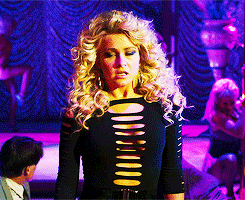
The songs within the film are emblematic of a period of rebellion, a genre dedicated to challenging norms and establishing its own realm of music. Songs like "I love Rock and Roll," "Wanted Dead or Alive," "I Want to Know What Love is," and "Hit Me With Your Best Shot" are all emblematic of societal reflections imposed onto the characters within the narrative. Catherine Zeta-Jones' character Patricia Whitmore is the film's main antagonist in her disdain for rock music. But quickly, through seduction of a famous musician, she is quickly swayed away from hatred and into a total state of enamor.
The music also serves to explore the faults of the rock industry as well by exploring all avenues of glitz, glamor, and obstacles.
How do the historiographies of previously recorded songs inform audience relationships with the musical’s narrative and performers?
As aforementioned, the history of rock not only permeates the soundtrack but the narrative as well. Though paranoia surrounding rock music came from conservative and religious groups fearing and overtaking of Satanists, many famous rock musicians and bands struggled with substance abuse. The star of the film, Stacee Jaxx (Tom Cruise) is a mirror into the lives of former rock stars struggling with the weight of their fame. Throughout the film he goes in and out of sobriety, though for the most part he remains absurdly intoxicated especially while performing.
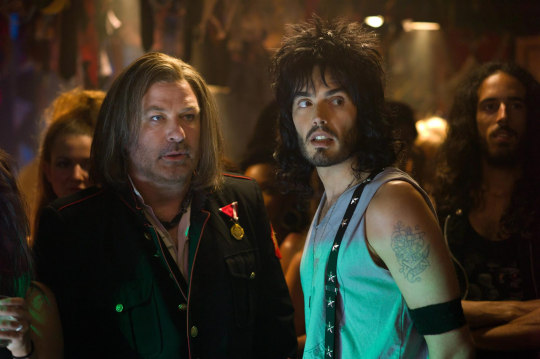
The text discusses how music integrates itself with culture by influencing attitudes, fantasies, politics, and listening communities (7) and that it was much "easier to describe rock's style negatively - to describe what it wasn't" (8). Because rock was new, it was perceived to be threatening, especially because it was powerful. In the film specifically the characters revolve their lives around the music as if their existence depended on it.
Each character has their own relationship to the industry which are uniquely expressed through different rock artists and bands. Whilst picketing Stacee Jaxx and rock music in general, Patricia Whitmore (Zeta-Jones) tells the rock fans to hit her with their best shot, superbly vocalizing Pat Benatar's epic 1980 single.
youtube
When Sherrie struggles to make it big she lands herself a job in a strip club where she and the rest of the dancers harmonize alongside Mary J. Blige for a version of "Anyway You Want It."
youtube
But even those who fear the music at the beginning of the film learn to love it by the end.
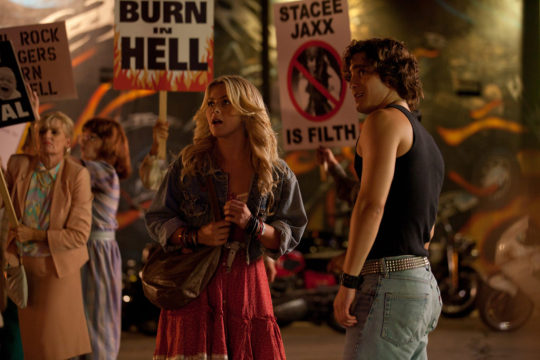
What musical genre/style drives the film’s score, and how does the genre/style (re)define the film as a musical?
Rock music is the SOUL of this film. It is the only music included which I think really defines the heart of the narrative and the power behind the battle of fighting for the music, as well as everyone's individual career. This influence is in the HAIR, their CLOTHES, their MAKEUP, and their connection to each other.
In order to examine the genre of the film that is inspired by the music, I want to just showcase what these artists looked like and how they performed their art.
Jon Bonjovi.
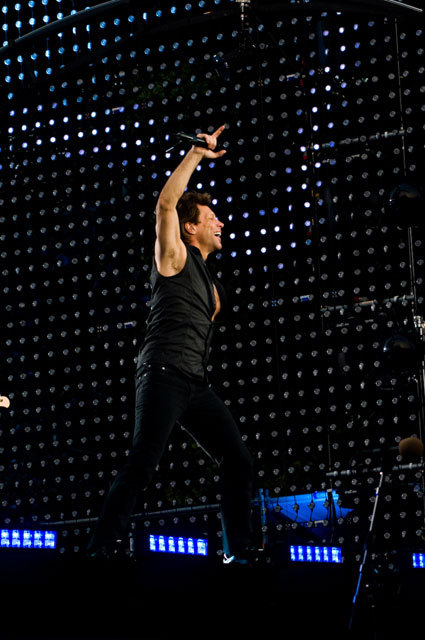
The vision herself, Pat Benatar:
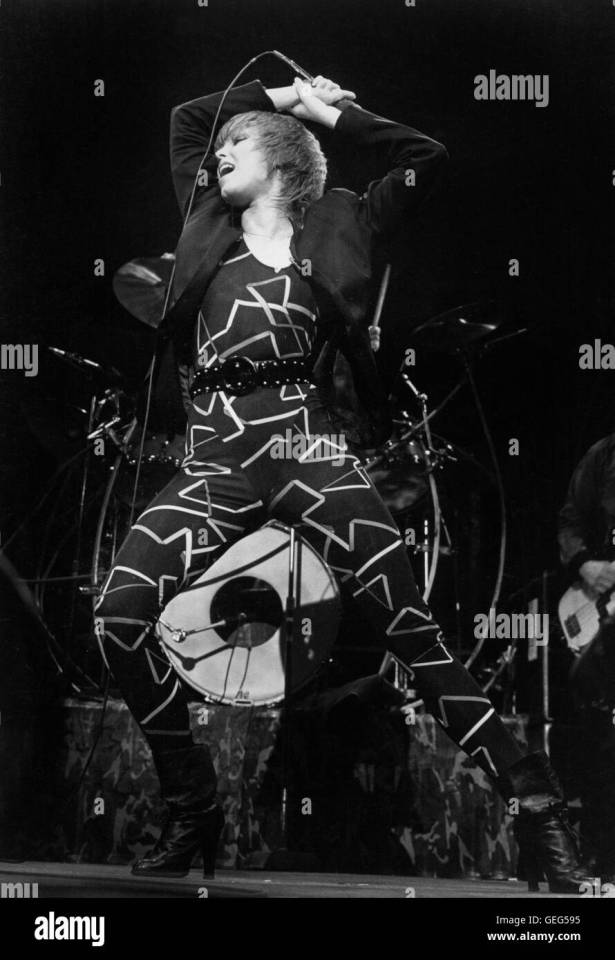
Whitesnake:
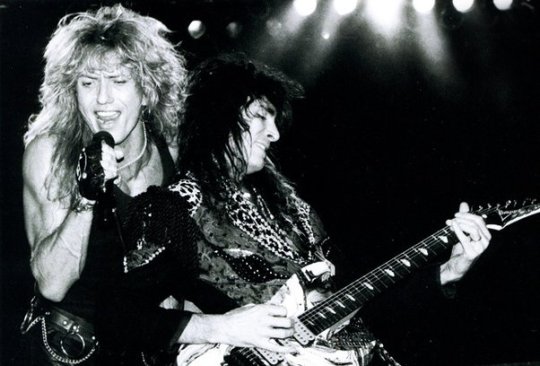
Def Leppard at their first concert:
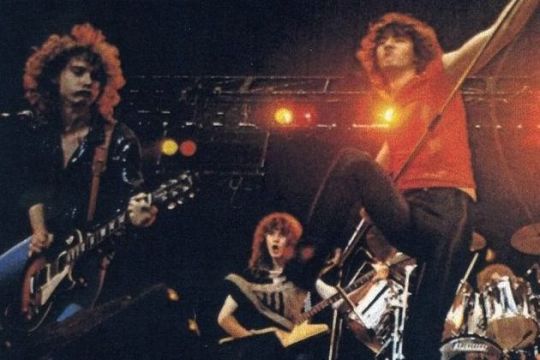
To really capture this energy wouldn't have been possible for the film for what it intended to be as the songs have a bit more of a pop influence for the film, which I would argue makes the music more digestible in order to reach a larger audience. However, I believe keeping the songs in the same style would have created a more realistic tone for the film.
@theuncannyprofessoro
18 notes
·
View notes
Text
What I find interesting about a film like this one is that the music is reflective of their cohesiveness in a way you don't see often in musicals. Whereas in most musicals, the numbers are performed perfectly and smoothly such as is the point, but it is different with this film. In Pitch Perfect, the girls are training to be a cohesive group of singers while also a group of young women, naturally there will be turbulence. This is reflected in how they sing, and perform in general.
Pitch Perfect (2012) by Jason Moore
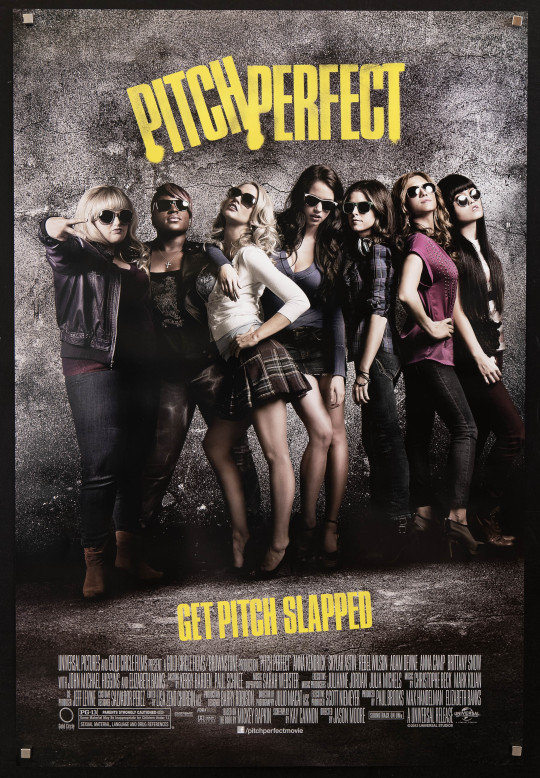
What are the social aspects within the film's narrative that align with the film's songs?
The film’s setting in a college aligns with the songs and narrative, as this enhances themes of social institution structures in regards to race, gender, and status. As Beca enters college with no friends, she tries to find a community through clubs that are rooted in the cliques and established ties. But, once she was discovered by Chloe, a member of the Bellas, she asks to audition for the acapella group due to the lack of members, leading Beca to audition and join the group. Through the Bellas', we see a mixed group of people with different backgrounds and personalities, leading Aubrey to try to change the groups differences to oneness. This brings Beca and Aubrey to be in constant division of each other, effecting the group's dynamic. These disagreements pass the borders of the off-stage and on-stage narrative, as quarrels that are based on their differing personalities are placed during their performances. But, as the narrative continues, they find community in each other through their love of music and singing together as a group. The film's focus on diversity and popular culture of the time through the connected genre of satirical comedy that is shown through both the characters and group relationships that connect to their college environment.
youtube
How do historiographies of previously recorded songs inform audience relationships with the musical's narrative and performers?
We see the different acapella groups use songs that correlate to their identities, as the TroubleMakers use songs that exert romance and desire through a male perspective that connects to their “bad boy” personalities and the Barden Bellas use songs that have been sung throughout the group's generations, which matches with their traditional looks that are expressed through their stage outfits, dance, and stuck-up personalities of some members. But, throughout the film, the relationship between the groups develops, and the final performances show a change in group dynamic that is expressed through song. We see these changes through their amping of their stage outfits, choreography, and choice of songs that range from "Price Tag" by Jessie J and "Give Me Everything" by Pitbull, Ne-yo, and Afrojack. Specifically, Beca's choice of singing "Don't You (Forget About Me)" by Simple Minds to send a message to Jessie, a member of the troublemakers, for a second chance, as the song is based off their time watching The Breakfast Club (1985). The chosen songs within the film are not merely to connect to the narrative, but rather the relationships of characters that are intertwined with songs that represent their growth individually and together as a group.
youtube
What musical genre/style drives the film's score, and how does the genre/style (re)define the film as a musical?
Through Beca's help, the group decides to ditch the songs of tradition and mix songs of different genres that reflects on Beca's background of DJing and aspirations of music production. This reflects the film's intentions of performing songs that are based on mixing of songs in the form of acapella. This comes with different stylistic sounds within each group and the creation of a refreshing take on the expanding genre of musical. A particular scene of the film known as the "Riff Off" is a game played by the acapella groups, as a chosen genre is picked and groups must sing songs in the genre and find a flow within each song that is sung through continuation of lyrics and beat. This game mirrors the idea of mixing songs, whilst using acapella as a way to create melody. This shows a modern take on musicals, as these genres were gaining popularity during this time.
youtube
14 notes
·
View notes
Text
I like you make note of the fact that show business is grueling in more ways than one. Even when Joe is attempting to reinvent himself, and move away from the heartlessness exhibited by him earlier in the film, it is still a grueling process in its own right. Show business is about keeping people's attention, so I think this idea of reinventing one's creative process over the years and allowing to change oneself too is quite harsh on the mind and body, a very interesting thing to point out.
Roundtable 3: All That Jazz (1979) directed by Bob Fosse
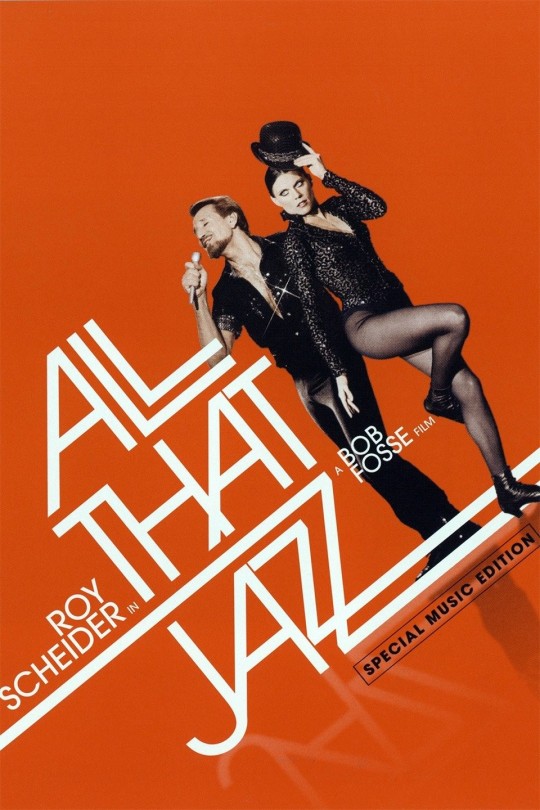
Question 1: What are the social aspects within the film’s narrative that align with the film’s songs?
The narrative of “All That Jazz” explores the dark side of entertainment. In the opening number, “On Broadway”, the audience is introduced to the allure of show business while being shown the grueling audition process.

The upbeat R&B song, performed by George Benson and popularized by The Drifters in 1963, complements the energized dancers and fast moving tryout. The lyrics of the song express longing and escapism, with the narrator dreaming of making it big on Broadway. However, beneath the glittering lights and promising opportunities lies a darker reality. The director, Joe Gideon, uses his artistic prowess and influence over the production to lead casting decisions based on who he wants to sleep with rather than talent.
He begins a sexual relationship with one of the dancers he chooses from the sequence, Veronica, and in a future scene he essentially breaks her down to tears in order to get the performance he wants out of her. To bring it back to “On Broadway”, the tension between the glamorous facade and the seedy underbelly of show business reflects another tension in the film which is a broader dichotomy in the entertainment world, where personal ambition often beats out artistic and personal integrity.
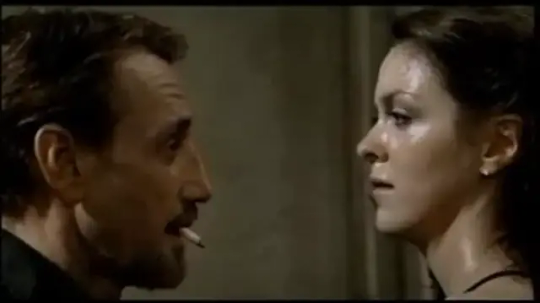
The scene between Veronica and Joe.
Another social aspect explored within the film’s narrative through song is the cyclical nature of life and art in “Everything Old is New Again”. The song was originally by Peter Allen in his 1974 album “Continental American”. As Joe grapples with his morality and attempts to reinvent himself creatively, the song serves as an important reminder of the cycle of birth, death, and rebirth, suggesting that trends and fashions often repeat over time. During the 1970s a large number of traditional values were being challenged and individuals sought to redefine themselves in the ever-changing and evolving world. Joe is able to find comfort and define himself with the comfort of the cyclical nature of art and life.
youtube
Question 2: How do the historiographies of previously recorded songs inform audience relationships with the musical’s narrative and performers?
The use of previously recorded songs in “All That Jazz” seeks to add layers of meaning to a specific audience familiar with their original contexts, an audience of Broadway and the style of bygone eras. For example, “Some of These Days”, a song associated with vaudeville performer Sophie Tucker, is used in a scene where Joe faces his mortality. Audiences familiar with Tucker’s career may interpret the song as a nod to the past, invoking a sense of nostalgia and paying homage to the rich history of stage productions and entertainment that predate Joe Gideon’s era which is inspired by Bob Fosse’s life.

Sophie Tucker
youtube
Similarly, “Bye Bye Love” originally by The Everly Brothers is used in a scene where Joe grapples with the dissolution of his relationships. The lyrics of the song become more significant in this context, reflecting Joe’s sense of loss and longing.
Question 3: What musical genre/style drives the film’s score, and how does the genre/style (re)define the film as a musical?
The music of “All That Jazz” encompasses a wide range of musical genres and styles including, jazz, pop, classic R&B, and traditional Broadway music. The eclectic mix reflect the diverse taste and influences of its director, Bob Fosse. By mixing the different genres, the film defies categorization and helps to redefine the musical genre.
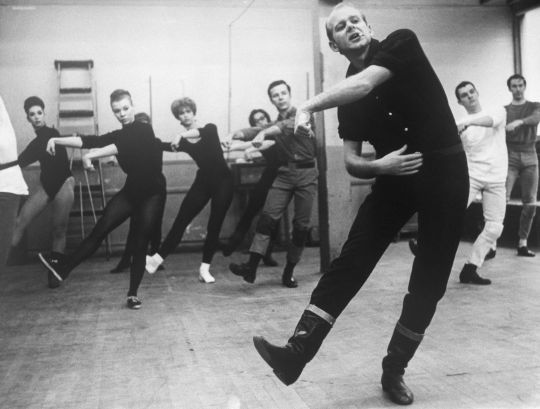
Bob Fosse in a situation similar to one we see Joe in many times during the film.
Unlike some jukebox musicals which adhere to a singular style or formula the film embraces experimentation and innovation. The film uses non-linear storytelling, surreal imagery, and unconventional musical numbers to challenge audience expectations. It doesn't feel like what one might think of as a musical, it feels more like a prolonged fever dream of a performance.

The Angel of Death that Joe converses with and performs for throughout the film in surreal scenes.
16 notes
·
View notes
Text
I like what you said about timeless relationships in your analysis. My film also did the same, but in reverse. Instead of classic songs with a modern setting, it was modern songs in a classic setting of 1890s Paris. I think with films, especially those about love it is important to make them feel timeless, so that the film can live on in the audience's own experiences.
Romance and Cigarettes
Today, I'm diving into the world of jukebox musical films, and my pick is the underrated gem, "Romance and Cigarettes." Strap in for a wild ride of love, music, and unexpected moments!
youtube
Social Aspects and Musical Narratives: "Romance and Cigarettes" is a whirlwind of emotions, and its songs serve as the heartbeat of its narrative. The film explores themes of love, infidelity, and familial bonds, and each song mirrors the characters' inner turmoil and desires. For instance, when characters are at odds with their partners, songs like "Piece of My Heart" by Janis Joplin or "I Want Candy" by Bow Wow Wow intensify the emotional tension on screen. The juxtaposition of classic tunes against modern settings adds layers of complexity to the characters' struggles, highlighting the timeless nature of human relationships.
youtube
Historiographies and Audience Relationships: What sets "Romance and Cigarettes" apart is its use of previously recorded songs to drive the story forward. These iconic tracks carry their own histories and meanings, which enrich the audience's connection to the film's narrative and performers. When we hear Elvis Presley's "Trouble" or James Brown's "It's a Man's Man's Man's World," we're not just listening to music; we're tapping into a collective cultural memory that enhances our understanding of the characters' experiences. The familiarity of these songs fosters a sense of nostalgia and empathy, drawing audiences deeper into the film's world.
Musical Genre and Style: "Romance and Cigarettes" defies traditional genre boundaries, blending elements of rock, pop, and soul to create a dynamic and eclectic score. This mishmash of musical styles reflects the film's unconventional narrative structure and characters, (re)defining it as a jukebox musical unlike any other. Whether it's Kate Winslet belting out "And When I Die" or Christopher Walken serenading us with "Delilah," each performance adds a unique flavor to the film's overarching musical tapestry.
youtube
In conclusion, "Romance and Cigarettes" is a bold and refreshing take on the jukebox musical genre, weaving together a tapestry of music, emotion, and storytelling that captivates audiences from start to finish. Can't wait to hear your thoughts!
youtube
15 notes
·
View notes
Text
I like how in your analysis you point out that Gene Kelly did contribute a lot of star power to this film. He was an extremely talented dancer and singer, so it seems appropriate that for a film meant to encourage post-war optimism would utilize this kind of presence.
Roundtable 3: An American in Paris
"An American in Paris" is a classic musical from 1951, directed by Vincente Minnelli and featuring the lively music of George Gershwin. The film stars Gene Kelly as Jerry Mulligan, an American painter living in Paris, who falls in love with a beautiful dancer named Lise, played by Leslie Caron.

What are the social aspects within the film’s narrative that align with the film’s songs?
Cultural Exchange and Integration, "I Got Rhythm": Jerry Mulligan performs this song when surrounded by French children. The scene illustrates the cultural exchange between the American protagonist and the local Parisians. Jerry, who is an American, uses his charm and artistic flair to connect with French culture, which is receptive but also distinct. It symbolizing the blend and appreciation of different cultures.
youtube
Post-War Optimism and Recovery, “I’ll Build a Stairway to Paradise": Performed during a lavish nightclub scene, this song reflects the luxurious and escapist environments that became popular in post-war Europe as a way to move past the hardships of World War II. The entertainment industry, including nightclubs and music halls, played a crucial role in this societal recovery.
youtube
How do the historiographies of previously recorded songs inform audience relationships with the musical’s narrative and performers?
Period Reflection: The songs selected for the film not only reflect the musical zeitgeist of Gershwin's time but also evoke the vibrant energy of the Jazz Age and the subsequent years. This cultural embedding helps the audience connect the narrative’s setting—post-war Paris—with the broader historical narrative of American music and its influence.
Gene Kelly’s Star Power: Gene Kelly was not just an actor but a celebrated dancer and singer whose performances were major draws for audiences. His ability to embody the spirit of Gershwin’s music through dance (particularly evident in the ballet sequence) and song significantly influences how audiences perceive and connect with the film. Kelly's own history and persona as a performer add an additional layer of appreciation and engagement for the audience.
What musical genre/style drives the film’s score, and how does the genre/style (re)define the film as a musical?
The musical genre that primarily drives the score of "An American in Paris" is a fusion of classical and jazz music, uniquely embodied through the compositions of George Gershwin.
Redefining Musical Film Structure: Unlike many musicals of the time, which often featured scores written directly for the screen, "An American in Paris" uses a pre-existing, concert-oriented score that is adapted into the film's narrative. This approach allowed the film to explore more complex musical forms typically associated with the concert hall rather than the musical stage. The extended ballet sequence set to Gershwin‘s "An American in Paris" is a prime example, offering a narrative told almost entirely through dance and music, reminiscent of a classical ballet but infused with jazz energy.
Broadening Audience Appeal: The integration of jazz with classical music broadened the film's appeal, attracting not only traditional fans of musical theater but also those who appreciated more serious musical forms. This crossover appeal helped redefine what a musical film could be, making it both a popular entertainment medium and a serious artistic endeavor.
13 notes
·
View notes
Text
I thought the way the film incorporates the music into the film in a way that seems almost like a music video sort of contributes to this fantastical concept of traveling through the universe. Do you think the film would have the same effect if the musical numbers weren't filmed different from the rest of the story?
Roundtable: Across the Universe (2007) dir. Julie Taymor
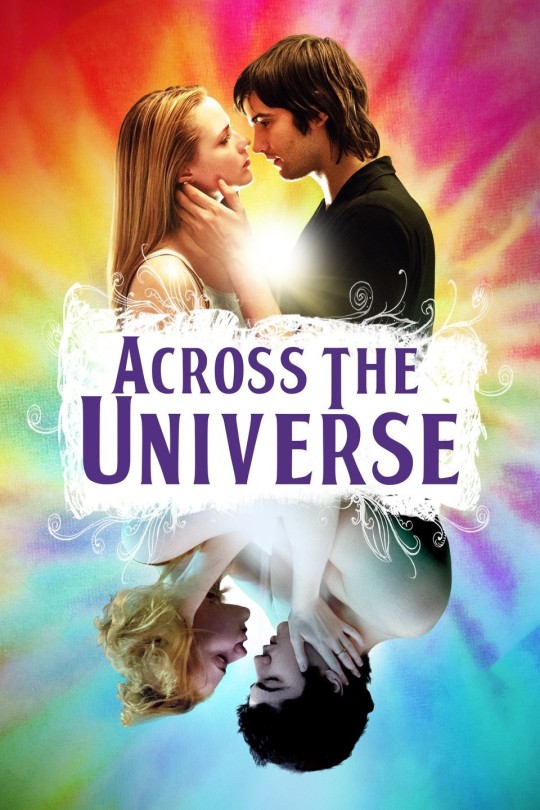
Across the Universe transforms thirty-three popular songs by The Beatles into a wacky musical odyssey that explores the highs and lows of youth counterculture movements in 1960s US and Britain. With major characters named Jude, Lucy, and Prudence who all have obvious namesakes from within the Beatles' discography, the lyrics and perspective of the bands' music informs the characters' attitudes and circumstances throughout the film. Though it's unclear whether the Beatles exist in the films' universe, which seems to be an imagined caricature of the 60s, its certain that Taymor believes their music captures the essence of the sixties, as the (mostly white and well-off) characters sorrowfully sing their way through the turmoil of the Vietnam War and the Civil Rights movement....

At times, this film relies on cinematic narrative expectations, and at others, the film feels like a two-hour long Beatles music video. Some creative risks are taken, such as an LSD-sequence or a highly choreographed interpretation of the military drafting process during the Vietnam War. Though the film is fun when it indulges in its wackiness, I found that it was stuck between following a narrative structure and subverting it, causing it to feel unsatisfying, disjointed and generally underdeveloped.
With this in mind, there's a lot of small characters and storylines that make the film a bit difficult to summarize. Here's a synopsis from Google:
When young British worker Jude (Jim Sturgess) sets sail for the United States in search of his father, he ends up meeting carefree college student Max (Joe Anderson) and his lovely sister, Lucy (Evan Rachel Wood), along with a cast of eccentric characters. As Jude and Lucy fall for each other, their relationship is threatened by the social upheaval that accompanies the Vietnam War.

Social Aspects Through Song
The "social aspects" of Across the Universe are conveyed through the films' songs in a way that is incredibly on-the-nose and un-subtle. In fact, nothing about this film is subtle. For instance, when unemployed artist Jude is upset with his booked and busy girlfriend for being too involved in the anti-war movement, he shows up at the nonprofit and starts singing "You say you want a revolution..." In another sequence, Max prepares to be screened for military service, and giant Uncle Sam posters come to life and start singing "I want you."
youtube
youtube
With such un-nuanced recreations of political events, I am unsure of what exactly this film is trying to say about the 1960s' political and social revolutions from a 2007 vantage point. On the contrary, perhaps the film is attempting to create an "objective" yet campy and fun retelling of 60s history with a focus on the youth, without deliberately trying to "say" anything new at all. With this non-argumentative lens, the film seems blissfully unaware of its own shortcomings, such as the unresolved sexism of its two male leads, or the surface-level characterization of Lucy and the heavily apparent absence of the second-wave feminist movement.
Perhaps the most questionable of this films missteps, though, is its treatment of race through song. The film's secondary cast features a queer Vietnamese female character, Prudence, who randomly disappears from the film a third of the way in. Then there is Jo-Jo. When it is revealed to the characters that Martin Luther King Jr. was assassinated, the film cuts to Jo-Jo, a Black man, singing at a bar, only to reveal that his sad song is actually about Sadie, the woman who left him. While social issues of race clearly loom over the characters' heads, the film employs the powers of the Beatles' "All You Need is Love" rhetoric to wash over any nuance pertaining to the topic. This is especially interesting since this rhetoric within actual hippie circles in the 1960s proved to be a clear failure.
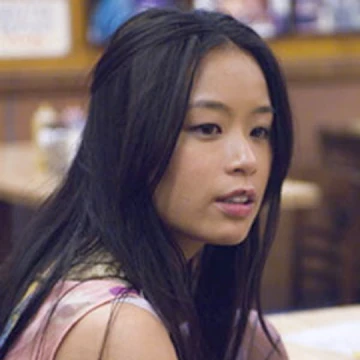
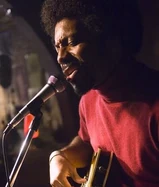
Musical Memories and Genre-bending
On the changing force of pop music within the movie musical format, Mira writes: "In assessing what pop songs bring to the musical, we must consider, firstly, that a song's meaning is conveyed not only through melody, rhythm, and lyrics: engaging with an audience's memories, viewpoints, and personal background can be powerful in unleashing meaning as well" (24). In this sense, I think Across the Universe transforms its musical source material and plays with audience's familiarity with its songs in a really fun and effective way.
The film's opening is a really great example of how it blends the audiences' diverging associations of a classic Hollywood musical versus a classic rock music video. These two juxtaposing numbers comprise the opening:
youtube
youtube
Within this introduction, we are already hit with three different musical styles: the Beatles' contemplative ballads through Jude, a more intense female rock voice, and a more classical "musical theatre" style through Lucy. However, all of the songs sung are by the same artist. In this way, the film often plays around with the melodies, keys, tempos, etc. of the original Beatles' songs in order to suit which character is singing a given song. I think this is a really clever way of making similar-sounding music feel dynamic enough to remain interesting for the span of a two-hour film while also serving practical narrative functions. The songs of the Beatles are also transformed to song like other artists or sub-genres of 60s rock and roll. For example, the character Sadie's songs are reminiscent of rock stars like Stevie Nicks or Janis Joplin, while Jo-Jo's skilled guitar playing is inspired by the likes of Jimi Hendrix. In this way, the film pays homage to several icons of the era, despite only using actual music created by one band of the time.

14 notes
·
View notes
Text
I think it was really clever the way the film uses the songs "I will follow him" and "My Guy" by changing their purpose for the narrative. Something else I really like about Sister Act is how both aspects of the story contribute to one another. Whereas Dolores learns from her experience at the convent, the people she meets also learn from her, and both contribute to their betterment.
Sister Act (1992)
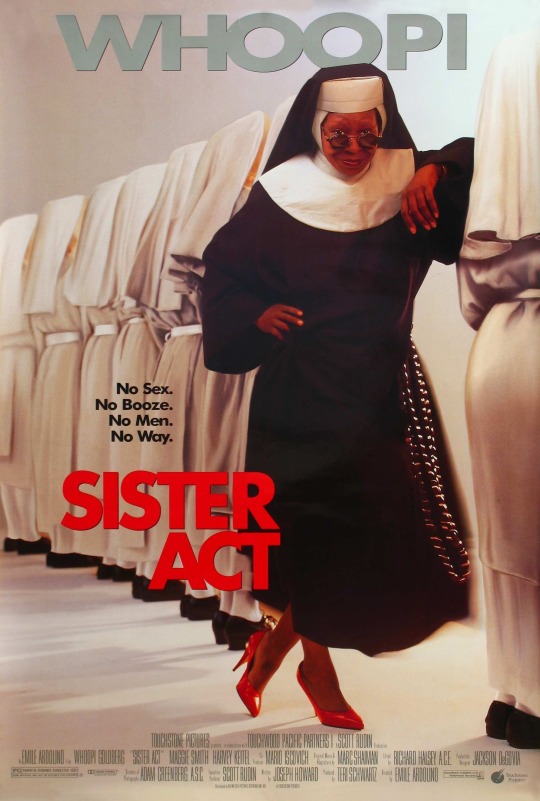
Directed by Emile Ardolino in 1992, Sister Act is a comedy film starring Whoopi Goldberg as Deloris Van Cartier, a lounge singer who witnesses a murder and is placed in protective custody in a convent. Disguised as a nun, Deloris clashes with the strict Mother Superior (played by Maggie Smith) but ultimately helps transform the struggling choir into a musical sensation. Along the way, Deloris finds redemption, friendship, and a sense of purpose. The film combines humor, music, and themes of empowerment and sisterhood to deliver an uplifting and entertaining story.
Deloris' backstory in Sister Act reveals a poignant journey from her childhood in a Catholic school to her adult life as a singer in Reno. As a child, Deloris attended a Catholic school, presumably imbued with the teachings and traditions of the Church. However, for reasons undisclosed in the film, she ultimately departed from that environment, symbolizing a rupture in her connection to her faith and the Church.

Years later, Deloris finds herself pursuing a career as a singer in Reno, embodying a lifestyle far removed from her religious upbringing. Her departure from the Church as a child and her subsequent immersion in secular pursuits represent a thematic departure from spiritual values and community ties. However, the narrative arc of Sister Act intricately weaves Deloris' return to the Church into its storyline. When Deloris becomes a witness to a crime and is placed in protective custody in a convent, she is forced to confront her past and reconcile with her roots. Through her experiences within the convent, particularly her involvement in revitalizing the choir, Deloris undergoes a profound personal and spiritual transformation.

The film eloquently explores Deloris' initial apprehension towards convent life, juxtaposed against the urban landscape of San Francisco. This juxtaposition serves as a metaphorical reflection of societal disarray, wherein the Church stands as a beacon of hope amidst urban decay. Deloris' transformative impact on the choir symbolizes the catalytic force of individual agency within communities undergoing profound change. Through the medium of music, both Deloris' internal pilgrimage and the city's socio-cultural metamorphosis converge, highlighting the transcendent power of artistic expression to inspire collective renewal and redemption.

What are the social aspects within the film’s narrative that align with the film’s songs?
The social aspects within the film's narrative align with the film's songs in several ways. 1. Empowerment and Self-Discovery: Many of the songs in the film convey themes of empowerment and self-discovery, mirroring Deloris' journey as she finds her voice and purpose within the convent. Songs like "I Will Follow Him" and "My God (My Guy)" reflect Deloris' transformation from a self-absorbed performer to a woman who finds fulfillment in helping others and embracing her newfound community. 2. Unity and Sisterhood: The film's songs often emphasize themes of unity and sisterhood, echoing the bonds formed among the nuns despite their differences. Songs like "Hail Holy Queen" and "Just a Touch of Love" celebrate the camaraderie and support found within the convent, highlighting the importance of solidarity in overcoming challenges. 3. Redemption and Forgiveness: Through songs like "Bless Our Show" and "If You Wanna Be Somebody," the film explores themes of redemption and forgiveness, emphasizing Deloris' journey towards redemption as she confronts her past and seeks forgiveness from both herself and others.

How do the historiographies of previously recorded songs inform audience relationships with the musical’s narrative and performers?
As for the historiographies of previously recorded songs, they inform audience relationships with the musical's narrative and performers by adding layers of familiarity and nostalgia. Many of the songs featured in Sister Act are well-known hits from the 1960s and 1970s, such as "I Will Follow Him" by Little Peggy March and "My Guy" by Mary Wells. These songs evoke memories and associations from the past, connecting audiences to the film's setting and characters on a deeper level. Additionally, the use of familiar songs allows the film to play with audience expectations and reinterpret these songs within the context of the narrative, in this case changing love songs into songs praising God, creating moments of surprise and delight.

What musical genre/style drives the film’s score, and how does the genre/style (re)define the film as a musical?
The musical genre/style that drives the film's score is primarily gospel, with elements of soul and R&B. This genre/style redefines the film as a musical by infusing it with a vibrant energy and spiritual resonance that complements the themes of redemption and sisterhood. The use of gospel music not only adds authenticity to the setting of a convent but also elevates the emotional impact of key moments in the narrative. Furthermore, the incorporation of soul and R&B elements reflects the diverse backgrounds of the characters and contributes to the film's infectious sense of joy and celebration. Overall, the fusion of gospel, soul, and R&B genres in the film's score creates a dynamic musical experience that enhances the storytelling and leaves a lasting impression on audiences.

Deloris' journey of rediscovery and reconciliation mirrors the larger theme of redemption and the cyclical nature of faith. Deloris' return to the Church symbolizes not only her individual reconciliation but also a broader exploration of forgiveness, belonging, and the enduring power of faith to guide one back to their true self. In essence, her departure from and eventual return to the Church serve as a narrative framework through which the film explores themes of identity, redemption, and the enduring journey towards spiritual fulfillment.
youtube
13 notes
·
View notes
Text
As I was reading the analysis it sounded like it aligned with the traditions of white musicals. Especially because the story takes place in Italy, which works to remove the audience from reality and into a carefree space. I think the 80s music is a good decision for the soundtrack as the music during the 80s was very bold and carefree, contributing to the celebratory theme.
Walking on Sunshine (2014)

Walking on Sunshine is a 2014 British jukebox musical romantic comedy-drama film directed by Max Giwa and Dania Pasquini. The film features popular hit songs from the 1980s and is often compared to Mamma Mia!. The plot of Walking on Sunshine revolves around a young woman who travels to a beautiful coastal village in Italy to attend her sister's impromptu wedding. She soon discovers that the groom is her ex-boyfriend whom she’s still in love with. The story unfolds with a backdrop of sunny beaches and features plenty of singing and dancing to iconic 80s hits. The film is known for its energetic musical numbers and vibrant settings, even though it received mixed reviews for its storyline and character development.

What are the social aspects within the film’s narrative that align with the film’s songs?
In Walking on Sunshine, the use of vibrant 1980s pop songs directly correlates with the film’s themes of love, joy, and summer romance. Each song is chosen to enhance the film's emotional landscape and reinforce the relationships and conflicts between characters. For instance, the title track "Walking on Sunshine" by Katrina and The Waves is emblematic of the film's overall atmosphere of celebratory love and carefree spirit. The social context here is a nostalgic callback to the 1980s, a time perceived as colorful and full of energy, which mirrors the scenic, lively Italian wedding setting in the film.
youtube
How do the historiographies of previously recorded songs inform audience relationships with the musical’s narrative and performers?
The songs selected for Walking on Sunshine carry with them decades of history and individual memories, which help to establish a deeper connection between the audience and the narrative. The film's remix/rendition of "Girls Just Wanna Have Fun" and "Wild Boys" are pivotal in invoking a specific emotional and cultural recall from the audience. "Girls Just Wanna Have Fun," a feminist anthem of self-expression and independence, resonates with the film’s portrayal of strong, independent women navigating love and personal desires. This rendition allows the audience to connect with the characters' journeys through a familiar lens of empowerment and youthful rebellion. This song is interwoven with "Wild Boys" by Duran Duran. With its wild and energetic vibes, "Wild Boys" is used to underline themes of unruly passion and the tumultuous relationships among the characters. The use of these songs (as well as the costume choices in these scenes) not only enhances the narrative but also activates the audience's personal and collective memories, influencing their reception of the film's events and character arcs.
youtube
What musical genre/style drives the film’s score, and how does the genre/style (re)define the film as a musical?
Walking on Sunshine leverages the pop genre, particularly hits from the 1980s, as its driving musical force. Unlike traditional musicals that might rely on Broadway-style numbers, this film’s score is composed entirely of pre-existing pop songs. This choice significantly redefines the film’s classification within the musical genre by merging pop culture with cinematic storytelling. The upbeat and synthesizer-heavy music typical of the 1980s not only supports the film's energetic dance sequences and vibrant aesthetics but also modernizes the musical genre for an audience that might not connect with traditional musical theater. This redefinition makes the genre more accessible and relatable to a broader, possibly younger audience.
youtube
18 notes
·
View notes
Text
I think it is interesting how the film placed an emphasis on the visual execution of the music as well as the music itself. I feel like with this approach the audience can be more immersed in the purpose of the music in the film. I also feel like it would add to the grandness of the time, as it takes place during the prohibition era. During this time, acts against the prohibition were bold acts, so I feel the way in which the soundtrack is used in the film appropriately conveys that.
Idlewild - Roundtable Jukebox

Idlewild is a musical drama film released in 2006, directed by Bryan Barber and starring the hip-hop duo OutKast, which consists of André 3000 (André Benjamin) and Big Boi (Antwan Patton). The film is set in the Prohibition-era South and blends elements of music, drama, and crime with a jazz and hip-hop-infused soundtrack.
This was a beautiful film and very aesthetic. I have not seen another musical quite like this one and it’s for a reason. Here's why...
youtube
What are the social aspects within the film’s narrative that align with the film’s songs?
The characters in "Idlewild" demonstrate resilience in the face of adversity, a theme echoed in the film's music. Many songs highlight the characters' determination to overcome obstacles and fight for their dreams, reflecting the broader struggle for justice and equality.
The film's love songs align with these themes, expressing the joy, passion, and challenges of love.
Rooster's involvement in the criminal underworld is depicted through intense and energetic musical numbers that convey the danger and excitement of his lifestyle.
The film's songs reflect their desires for a better life and their struggles to achieve their dreams. Percival's introspective ballads, for instance, convey his longing to break free from his small-town life and pursue his passion for music.
youtube
How do the historiographies of previously recorded songs inform audience relationships with the musical’s narrative and performers?
Most of the songs in Idlewild had already been featured on the OutKast albums Big Boi and Dre Present...OutKast and Speakerboxxx/The Love Below, essentially making it a jukebox musical. Seven of the songs from the film, along with several unreleased songs, were released by LaFace Records as an OutKast album entitled Idlewild at the time of the film's release.
This is such an interesting question for my film considering all the film’s score was performed and produced by the lead actors, Andre 300 and Big Boi, with a few credited features in the film. Obviously it isn’t just circumstance that the leads were a famous Hip-Hop duo, so it isn’t hard to assume that the actors/artists were chosen specifically to star in this film for their transformative and notable music style and sound. Without their unique sound and talent for performing, the film could not, and would not be what it is.
The historiography of this film is unique in the way that the character actors are also the creators of the featured soundtrack. On one hand, the audiences may feel more compelled to the characters and their narrative because they are in support of their music exclusive to the film, as well as some of their originals. In general though, I think historiographies definitely inform the audience’s relationship to a narrative. It can make you more engaged with the characters and their conflicts if you personally feel the music is fitting, or on the other hand, it can make you understand and better comprehend the narrative you're following because you may be familiar with the meaning and significance of the music. I also think about people’s ability to see artists they like and songs they love being performed in a different medium. In a way, your brain might see the visuals from the first time they heard it; or maybe the song originally had a music video. It’s up to directors to build the narrative strongly around the music.
youtube
What musical genre/style drives the film’s score, and how does the genre/style (re)define the film as a musical?
The hip-hop, funk, and soul stylings of the song score are intentionally anachronistic, a choice made to complement the film being set in 1935. Elements of 1930s-era blues and jazz music are, however, featured prominently in many of the musical numbers. The film's dance numbers, choreographed by Hinton Battle, also feature many period dances, primarily the jitterbug and showgirl moves, like featured in the above video.
The film does a lot of blending hip-hop with jazz, blues, and gospel influences.
Idlewild is known for its visually stylized and innovative approach to storytelling, incorporating musical numbers, fantasy sequences, and animation.
The film defines itself by taking place in the 1930s, in addition to casting vetted performers and songwriters as your leads. The musical simply wouldn't have the same storytelling element had anyone else written the soundtrack, whether prior to the film or not.
#oxyfilmmusical #disguisedmusical @theuncannyprofessoro
19 notes
·
View notes
Text
I like how the film pays tribute to the artists properly despite the songs being used to different effect in the film. it is also interesting to think about how the pre-existing songs were used somewhat out of context of the narrative itself, but the emotion tied to them was enough to capture audiences.
The Blues Brothers

What are the social aspects within the film’s narrative that align with the film’s songs?
The Blues Brothers establishes the group of Nazi’s that follows them around as a central villain and point of ridicule throughout the film. Policing in general and law enforcement are also another social aspect within the narrative as both Jake and Elwood are running from the law. The film pokes fun at the extreme lengths law enforcement takes to arrest the Blues Brothers and their failure to do so. The film has several car chases with one spanning over 20 minutes, and a record of one hundred and four cars destroyed during filming. These ridiculous stunts constantly reaffirm that the Blues Brothers are on the other side of law enforcement. This type of narrative–music as rebellion and performance as protest–is bolstered by the film’s Rock and Roll and R&B soundtrack.
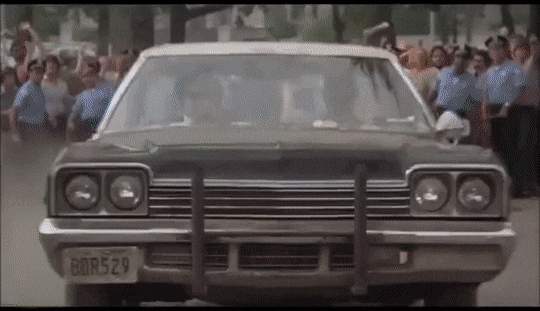
How do the historiographies of previously recorded songs inform audience relationships with the musical’s narrative and performers?
The historiographies of these previously recorded songs are what make this film special. The audience already has strong ties to the iconic performers and their songs, so any decontextualization for narrative continuity is minor. That is to say, this film doesn’t attempt to disguise performers like Aretha Franklin, Ray Charles, and Cab Calloway. It embraces their presence and the influence they hold as musicians. For example, “Think” by Aretha Franklin was released during the civil rights movement. When she performs it in The Blues Brothers, the narrative shifts the song's original meaning. Her character Mrs. Murphy asks her husband to think before he leaves to go off with the band. Despite this shift, the song’s original context is still very attached to the performance.
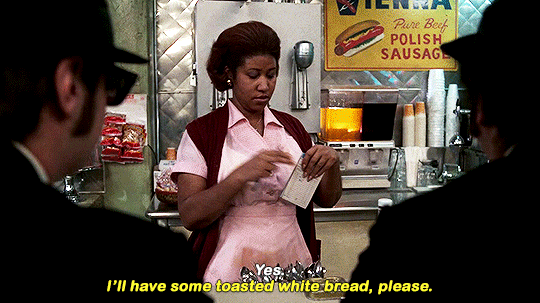
youtube
What musical genre/style drives the film’s score, and how does the genre/style (re)define the film as a musical?
Soul and R&B drive the film’s score with performances like “Think” performed by Aretha Franklin, “Minnie the Moocher” performed by Cab Calloway, and “Shake A Tail Feather” by Ray Charles. I think this choice of genre defines The Blues Brothers unique feel and makes the dry humor and slapstick comedy so successful. Despite being set in 1980, the film pays homage to iconic performers of the late 50s and 60s. Elwood and Jake are even made fun of for their black hats, sunglasses, and suits, but they maintain their signature “old-school” style throughout. The film's commitment to incredible performers is just one of the reasons it has become a classic.
youtube
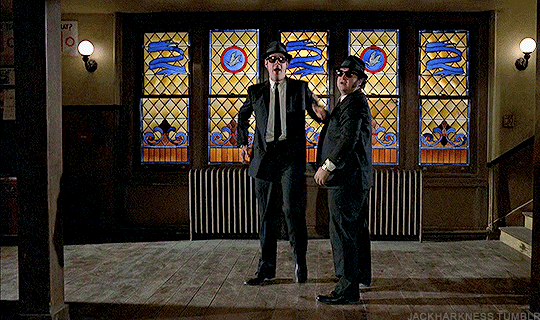
18 notes
·
View notes
Text
I like the concept of the film. I think it's an interesting approach to exploring the culture of band worship, especially as the film is a bit satirical. I think in this way the jukebox aspect of the musical has more of an effect for the message as the music is actually played by the original artists.
Roundtable III: A Musical In Disguise - Tommy (1975)
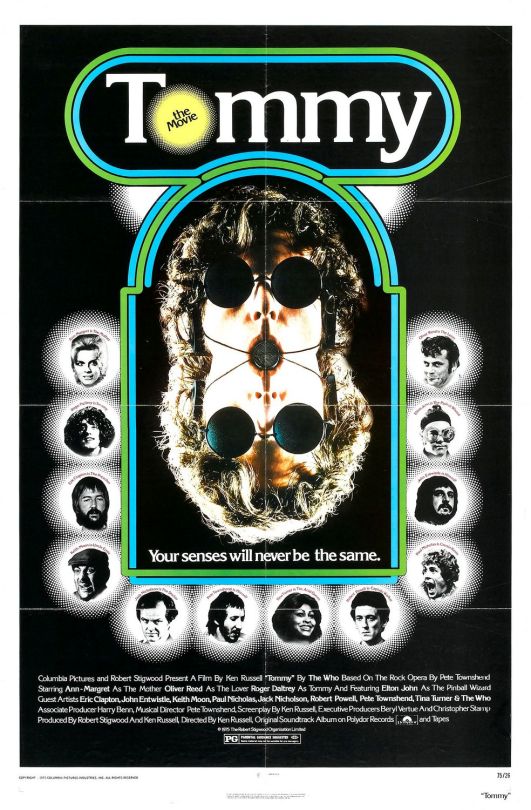
The film Tommy (1975), directed by Ken Russell, is a musical fantasy drama that follows a boy named Tommy after he watches his step father kill his father. After this incident, Tommy goes psychosomatically deaf, dumb, and blind. After Tommy discovers his great talent for playing the pinball machine, he accumulates a cult following that take his skills as divine powers. Eventually, Tommy regains his senses and attempts to sell cheap gimmicky products that he claims will give his followers his powers. Tommy is played by the harmonica player of the band The Who. The entire film is based on Tommy, the album by the who released in 1969.
What are the social aspects within the film’s narrative that align with the film’s songs?
The social aspects of the time centered around large crowds of rock and roll fans flocking to prominent bands. Tommy accumulates a cult following because of his sensational pinball skills, and the music for the film comes directly from the album Tommy, by The Who, who were a prominent rock band in the 60s and 70s. In fact, the whole film is based on the album. During the 60s and 70s, it was not uncommon for rock and roll bands to be worshipped like they were profits or gods. One band could take over the world. In this film, Tommy is portrayed as the second common of Jesus, granting abilities to his followers which come in the thousands.
youtube
How do the historiographies of previously recorded songs inform audience relationships with the musical’s narrative and performers?
The previously recorded songs being from the album Tommy, by The Who, engage the viewer with the musicals narratives of a rock and roll story. Tommy's story is one of great success and then tragedy as his own fans murder his mother and step father. The band The Who has a similar tragic past. The Who concert disaster of 1979 is evidence of how many rock and roll bands are involved in tragic accidents or downfalls. Even though the incident occurred after the making of this film, the concept still applies. A rock and roll band wanted to make a film, so they made it a tragic, yet epic musical - one which reflects their own careers.
youtube
What musical genre/style drives the film’s score, and how does the genre/style (re)define the film as a musical?
This film is a rock musical, starring a rock artist, using a narrative from a rock song, and other rock music from that specific band. This style of music makes the whole film a rollercoaster of fantasy surrealism. From one scene to the next there is emotional tensions, to violent conflict, to perfect calm. These ups and downs in such fantastical ways represent a rock and roll song, or even the life of a rock and roll artist. Watching the film, don't know what's coming next, and it's the same with a band like The Who. As Alberto Mira states: "pop musical, like many established cycles, ends up being about pop music, pop stardom, and their legacies" (32).
youtube
18 notes
·
View notes
Text
I think it's interesting that the film chose to avoid addressing race, though it's not surprising. This way, the film uses existing songs to create a focus on the romantic relationships. In a way, it almost makes it seem like focusing on love is the only other option if not race. However, I do believe in approaching the film this way it succeeded in putting an emphasis on the artistry of the music.
Roundtable Presentation: Stormy Weather (1943)

Stormy Weather is a 1943 musical directed by Andrew L. Stone. Stormy Weather made history being one of the earliest films with an all-Black cast to be released by a major American studio (being released by Twentieth Century Fox). The film follows the story of Bill Williamson as he recounts it years later in a series of flashbacks which depict his return from serving in World War I. Upon returning to the US, Bill meets Selina, a famous singer and performer. Over the course of the film, Bill grows closer to Selina as he travels to New Orleans in order to pursue the dream of becoming a performer himself. The film is full of numbers which employ jazz and swing music from the early half of the twentieth century.
What are the social aspects within the film’s narrative that align with the film’s songs?
Stormy Weather uses its songs in order to develop the diegesis and tone of the film, in addition to exploring its themes further. The film’s focus on romance and connections between people is explored through its use of songs like “I Can’t Give You Anything But Love, Baby”, “Aint Misbehavin” or the titular “Stormy Weather”. The film pointedly distances itself from making commentary about larger societal and cultural issues, however, as the setting which the characters occupy is devoid of any mention of race or class.
youtube

How do the historiographies of previously recorded songs inform audience relationships with the musical’s narrative and performers?
The historiographies of previously recorded songs help to inform audience relationships with Stormy Weather’s story, characters, and relationships between characters. By intertwining the film’s narrative with familiar songs, Stormy Weather situates itself within the tradition of American jazz and swing. By employing songs which had already built rich histories in American musical tradition, Stormy Weather enriches its narrative centered around performance and art. These known, preexisting songs are used as short hand for narrative development and fit seamlessly into the conceit of the film.

What musical genre/style drives the film’s score, and how does the genre/style (re)define the film as a musical?
Stormy Weather primarily employs jazz standards in developing its sonic tapestry. Its choice of songs covers a century’s worth of music – from the mid-1800s to the 1940s. Many of the songs used by the film were written or originally performed by Black artists like Ethel Waters or Andy Rafaz. By highlighting jazz music in a film depicting an all-Black cast, Stormy Weather helps to reclaim jazz within the Black community after a generation of appropriation by white audiences.
However, as most of the creative body behind Stormy Weather was white, the film depicts Black characters and narratives through a white lens. The film employs minstrel songs in its catalogue like “De Camptown Races”. The song was written in inaccurate AAVE and was intended to be sung in minstrel shows by white performers wearing blackface. “De Camptown Races” was introduced by the Christey’s Minstrel in 1850 and would be performed in minstrel shows throughout the nineteenth century.
youtube
While Stormy Weather was historic for its representation of the Black community, it also perpetuated harmful stereotypes through its ties to minstrelsy. The film opened up opportunities for Black actors, singers, and dancers in Hollywood by highlighting Black talent in leading roles; however, it fell short of making any statement on the treatment of people of color within companies or studios and it offered little characterization for its cast, a result of its own ties to racism and racist attitudes.
15 notes
·
View notes
Text
I like the idea of having an equal focus on both community and the individual relationships. I think the way this film did that through having both large scale numbers such as a flash mob which in itself is a display of community, and more intimate scenes just between the individual couples.
Roundtable: Sunshine on Leith
Sunshine on Leith tells the story of two soldiers, Ally and Davy, returning home to Edinburgh after a tour of duty in Afghanistan.

The social aspects of "Sunshine on Leith" are mirrored perfectly by the film's soundtrack, which consists mainly of songs by “The Proclaimers.” Some of the principal themes that we can see being explored in the movie are community, relationships, social class and identity, and the songs play a huge role in telling the stories. For example, “I’m gonna be (500 miles)” highlights the relationships, communal, familial, and romantic, between the characters. The flash-mob scene in Edinburgh's Princess Street reflects the importance of community and support networks while the cut to the other two scenes offers a much more intimate perspective on the struggles of having a loved one far away from home and/or being the person who returned home and finding a community and identity after living through such a traumatic experience. Similarly, “Letter from America”, speaks to feelings of longing, home, belonging, and the comfort found in familiar places. It underlines the importance of their hometown as a source of not only instability and solitude but also solace and familiarity—ironically.
youtube
The established history of The Proclaimers' songs adds another layer of meaning to "Sunshine on Leith" for audiences familiar with the band's earlier work, but it can reframe the audience's understanding of the songs, which are delivered in a much less punchy/rock style than their original versions. For instance, "Sunshine on Leith," a song traditionally played at funerals, adds depth to the emotional impact of the film. It is not played during a particular important scene but it is often playing softly during a scene of reflection or longing for home. On the other hand, a song like "Letter from America," written about long-distance relationships in general, becomes more poignant when applied to the specific context of war and separation after Jean and Liz’s intimate conversation in the film.
youtube
The music that drives the score of "Sunshine on Leith'' can be classified as a combination of folk rock and pub rock. The latter is a genre associated with The Proclaimers' music, which forms the backbone of the film's soundtrack. It often features acoustic guitars, sing-along choruses, and lyrics that deal with issues of the social realm, working-class experiences, and everyday life, which are elements that perfectly capture the film’s essence and the social fabric of it. On the other hand, while the film might not have full-blown pub scenes, the pub rock elements we find in the songs add a sense of vibrancy and camaraderie to the story.
“Sunshine on Leith" redefines the film as a musical by adding songs that provide a sense of gritty realism, reflecting the character’s working-class lives and the challenges they face after coming back from war. Folk rock and pub rock often have a more raw and unpolished sound compared to traditional musical scores. This choice adds a sense of gritty realism to the film, reflecting the characters' working-class lives and the challenges they face. The familiar melodies and relatable lyrics create a sense of shared experience within the film but also the audience, and unlike some musicals where the music takes center stage, this film uses its folk rock and pub rock score to enhance the story and characters. The music isn't just entertainment; it's an integral part of the narrative.
17 notes
·
View notes
Text
I like how the film incorporates the music to align with the very real personal struggles the members were going through at the time. Though the film is about Frankie Valli and the Four Seasons as a group, it does not forget the things they overcame and endured in their personal lives.
Jersey Boys - Jukebox Musical Roundtable
Jersey Boys, directed by Clint Eastwood, follows the story of the 1960s rock 'n roll group The Four Seasons comprised of Frankie Valli, Bob Gaudio, Tommy DeVito, and Nick Massi. The film focuses on their rise to fame and the challenges they faced along the way.
youtube
What are the social aspects within the film’s narrative that align with the film’s songs?
Jersey Boys aligns its musical selections with key social aspects of its narrative, each song underscoring elements of the personal and communal evolution of the characters. Set against a backdrop of the 1960s—a time of cultural upheaval and musical revolution—the film focuses on the personal struggles and successes of The Four Seasons. For instance, songs like "Sherry" and "Big Girls Don't Cry" resonate with the youthful exuberance and working-class ambitions of the band members, reflecting their hopes and the societal push towards a new musical era that merged pop with personal storytelling. The track "My Eyes Adored You" reflects Frankie Valli's personal losses and his perseverance amidst family tragedies, portraying a deeper social context of personal resilience and commitment, a common theme of the era's socio-cultural fabric. Thus, the film’s songs not only enrich the narrative but also mirror the complex interplay between personal identity and broader societal shifts.
Mira discusses this narrative integration as a staple of successful musicals, highlighting how songs in traditional musicals often serve to express unspoken thoughts or pivotal emotional moments. Though Mira doesn't mention this directly, I find this tactic of musicals to be extremely efficient in advancing timelines without having to explicitly inform the audience of the jump. Similarly, a musical number can encapsulate a wide variety of emotions and plot information, similar to a montage. Jersey Boys employs this technique effectively during sequences like Frankie Valli's rendition of "Can't Take My Eyes Off You," which encapsulates his feelings of triumph and personal turmoil.
youtube
How do the historiographies of previously recorded songs inform audience relationships with the musical’s narrative and performers?
The historiography of The Four Seasons' songs plays a crucial role in Jersey Boys by creating a bridge between the audience and the narrative, enhancing the authenticity and emotional engagement. Songs like "Walk Like a Man" and "December, 1963 (Oh, What a Night)" carry with them a historical weight that informs and deepens the audience's understanding of the times and trials the characters endure. These songs, embedded in the cultural memory of many viewers, evoke nostalgia and a sense of realism, making the historical context of the film more relatable and vivid. The familiarity of the music invites the audience into a shared experience, transcending the screen to tap into collective memories and emotions, thereby strengthening the connection to the film's portrayal of the characters and their journey.
Furthermore, the film's narrative structure diverges from the typical linear progression of many musicals. It employs a documentary-style format with characters breaking the fourth wall to address the audience directly which contributes to the historiography. The idea is to include the audience in the storytelling as both makers and viewers reflect on the monumental rise of a beloved American music group. This method adds a layer of meta-narrative commentary, reflecting on the construction of musical mythos itself, which Mira notes as a modernist touch in contemporary musicals.
[SEE 4TH WALL BREAK IN TRAILER ABOVE]
What musical genre/style drives the film’s score, and how does the genre/style (re)define the film as a musical?
Jersey Boys is driven predominantly by the crooner, Doo-Wop, and Rock 'n' Roll styles that characterized the 1960s music scene, particularly influencing the American pop music landscape. This genre choice not only serves to set the period context but also redefines the musical film by integrating biographical and historical realism with the traditional elements of musical theatre. The use of genuine songs from The Four Seasons' catalog, performed in contexts that closely mirror the real-life circumstances under which they were popular, adds a layer of authenticity that is sometimes absent in more stylized musical films. This approach allows Jersey Boys to maintain a foot in the conventional musical genre while also exploring more nuanced, character-driven storytelling, emphasizing the impact of time, place, and societal change on personal and professional lives.
The blend of traditional and innovative elements in Jersey Boys suggests a potential path forward for the Hollywood musical genre, one that respects its roots while evolving to meet contemporary tastes. Mira argues that for musicals to stay relevant, they must adapt by incorporating new styles and addressing modern audiences' expectations, which are more attuned to realism and complexity. I largely agree. I think there is room for the more traditional whimsy of the Hollywood musical if it is housed within more complex themes such as the possibilities we covered in class (humor, delusion, hallucination, satire, etc.).
Jersey Boys demonstrates that the musical genre can successfully incorporate realistic storytelling and complex character development without sacrificing the emotive power of musical performances. The film's ability to appeal to both fans of traditional musicals and new audiences suggests a versatile blueprint for future projects within the genre. The successful integration of music and story, along with a modern narrative approach, may well encourage more filmmakers to explore and innovate within the musical genre, ensuring its survival and relevance in the modern cinematic landscape.
This approach, rooted in the dual adherence to tradition and innovation, not only honors the genre's history but also paves the way for its continued evolution, as discussed by Mira in the broader context of Hollywood musicals adapting to cultural shifts.
youtube
youtube
18 notes
·
View notes